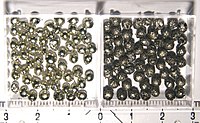
Photo from wikipedia
The control of interfacial thermal conductivity is the key to two−dimensional heterojunction in semiconductor devices. In this paper, by using non−equilibrium molecular dynamics (NEMD) simulations, we analyze the regulation of… Click to show full abstract
The control of interfacial thermal conductivity is the key to two−dimensional heterojunction in semiconductor devices. In this paper, by using non−equilibrium molecular dynamics (NEMD) simulations, we analyze the regulation of interfacial thermal energy transport in graphene (Gr)/hexagonal boron nitride (h-BN) heterojunctions and reveal the variation mechanism of interfacial thermal energy transport. The calculated results show that 2.16% atomic doping can effectively improve interfacial heat transport by more than 15.6%, which is attributed to the enhanced phonon coupling in the mid−frequency region (15–25 THz). The single vacancy in both N and B atoms can significantly reduce the interfacial thermal conductivity (ITC), and the ITC decreases linearly with the increase in vacancy defect concentration, mainly due to the single vacancy defects leading to an increased phonon participation rate (PPR) below 0.4 in the low-frequency region (0–13 THz), which shows the phonon the localization feature, which hinders the interfacial heat transport. Finally, a BP neural network algorithm is constructed using machine learning to achieve fast prediction of the ITC of Gr/h-BN two-dimensional heterogeneous structures, and the results show that the prediction error of the model is less than 2%, and the method will provide guidance and reference for the design and optimization of the ITC of more complex defect-state heterogeneous structures.
Journal Title: Nanomaterials
Year Published: 2023
Link to full text (if available)
Share on Social Media: Sign Up to like & get
recommendations!